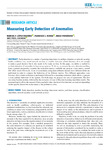Mostrar el registro sencillo del ítem
Measuring Early Detection of Anomalies
| dc.contributor.author | López-Vizcaíno, Manuel F. | |
| dc.contributor.author | Novoa, Francisco | |
| dc.contributor.author | Fernández, Diego | |
| dc.contributor.author | Cacheda, Fidel | |
| dc.date.accessioned | 2023-03-22T11:56:07Z | |
| dc.date.available | 2023-03-22T11:56:07Z | |
| dc.date.issued | 2022 | |
| dc.identifier.citation | M. F. López-Vizcaíno, F. J. Novoa, D. Fernández, y F. Cacheda, «Measuring Early Detection of Anomalies», IEEE Access, vol. 10, pp. 127695-127707, 2022, doi: 10.1109/ACCESS.2022.3224467. | es_ES |
| dc.identifier.uri | http://hdl.handle.net/2183/32744 | |
| dc.description.abstract | [Abstract] Early detection is a matter of growing importance in multiple domains as network security, health conditions over social network services or weather forecasts related disasters. It is not enough to make a good decision but it also needs to be made on time. In this paper, we define a method to evaluate detection of anomalies in time-aware systems. To do so, we present the early detection problem from a generic perspective, examine the evaluation metrics available and propose a new metric, named TaP (Time aware Precision). A set of experiments using three different datasets from different fields are performed in order to compare the behaviour of the different metrics. Two different approaches were followed, first a batch evaluation is performed, followed by a streaming evaluation which allows to present a more realistic behaviour of the systems. For both steps, we propose two sets of experiments. The first one using baseline models, followed by the evaluation of a set of Machine Learning algorithms results. The presented metric allows the amount of items needed to take a decision to be taken into account, not depending on the specific dataset but on the nature of the problem to solve. | es_ES |
| dc.description.sponsorship | Xunta de Galicia; ED431G 2019/01 | es_ES |
| dc.description.sponsorship | This work was supported in part by the Ministry of Economy and Competitiveness of Spain and Fondo Europeo de Desarrollo Regional (FEDER) Funds of the European Union under Project PID2019-111388GB-I00; and in part by the Centro de Investigación de Galicia-Centro de Investigación en Tecnologías de la Información y las Comunicaciones (CITIC) Funded by Xunta de Galicia and the European Union (European Regional Development Fund-Galicia 2014-2020 Program), under Grant ED431G 2019/01. | es_ES |
| dc.language.iso | eng | es_ES |
| dc.publisher | IEEE | es_ES |
| dc.relation | info:eu-repo/grantAgreement/AEI/Plan Estatal de Investigación Científica y Técnica y de Innovación 2017-2020/PID2019-111388GB-I00/ES/DETECCION TEMPRANA DE INTRUSIONES Y ANOMALIAS EN REDES DEFINIDAS POR SOFTWARE | es_ES |
| dc.relation.uri | https://ieeexplore.ieee.org/document/9963563 | es_ES |
| dc.rights | Atribución 4.0 International (CC BY 4.0) | es_ES |
| dc.rights.uri | http://creativecommons.org/licenses/by/3.0/es/ | * |
| dc.subject | Early detection | es_ES |
| dc.subject | Machine learning | es_ES |
| dc.subject | Network security | es_ES |
| dc.subject | Real-time systems | es_ES |
| dc.subject | Social network services | es_ES |
| dc.subject | Time-aware metrics | es_ES |
| dc.title | Measuring Early Detection of Anomalies | es_ES |
| dc.type | info:eu-repo/semantics/article | es_ES |
| dc.rights.access | info:eu-repo/semantics/openAccess | es_ES |
| UDC.journalTitle | IEEE Access | es_ES |
| UDC.volume | 10 | es_ES |
| UDC.startPage | 127695 | es_ES |
| UDC.endPage | 127707 | es_ES |
| dc.identifier.doi | 10.1109/ACCESS.2022.3224467 |






